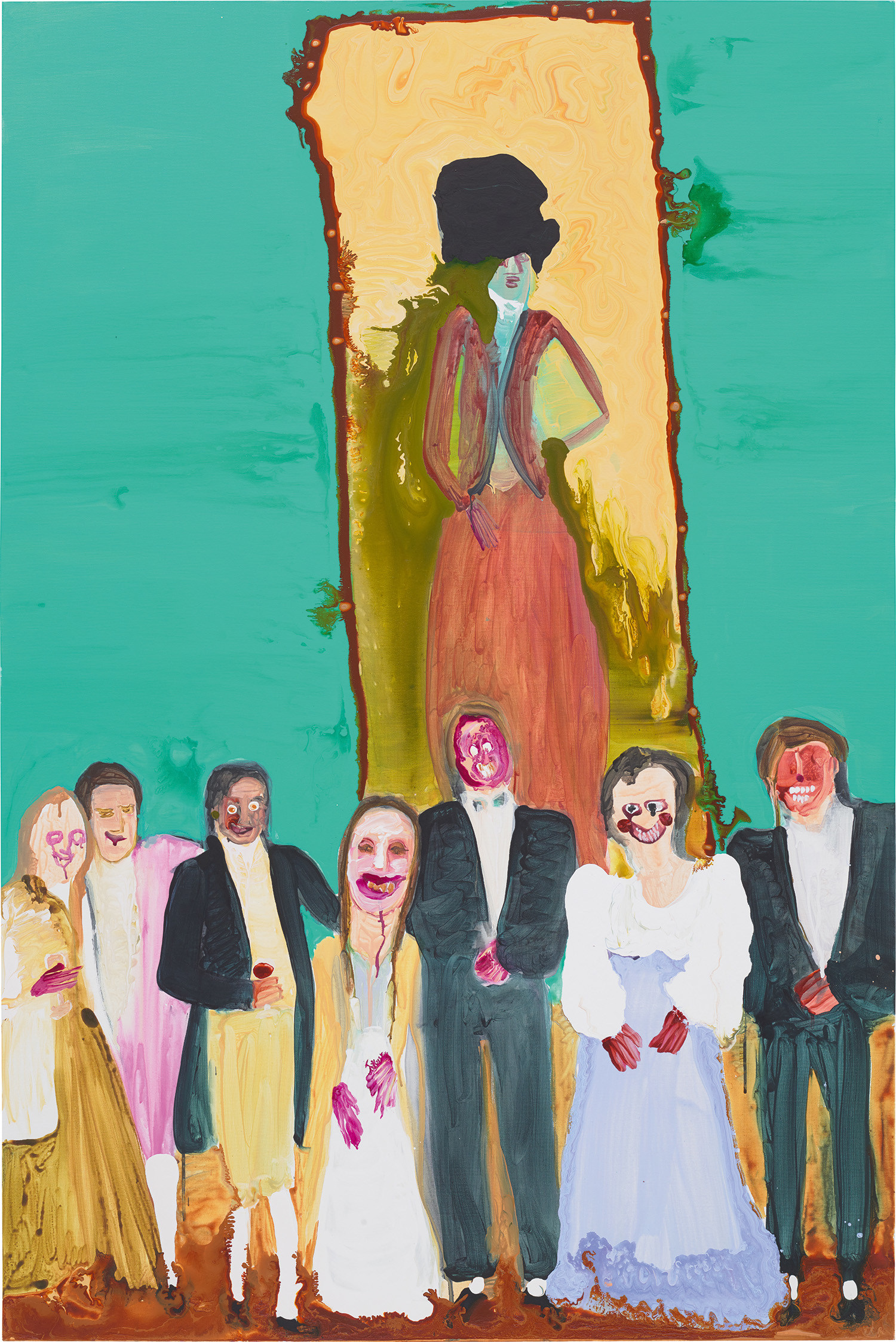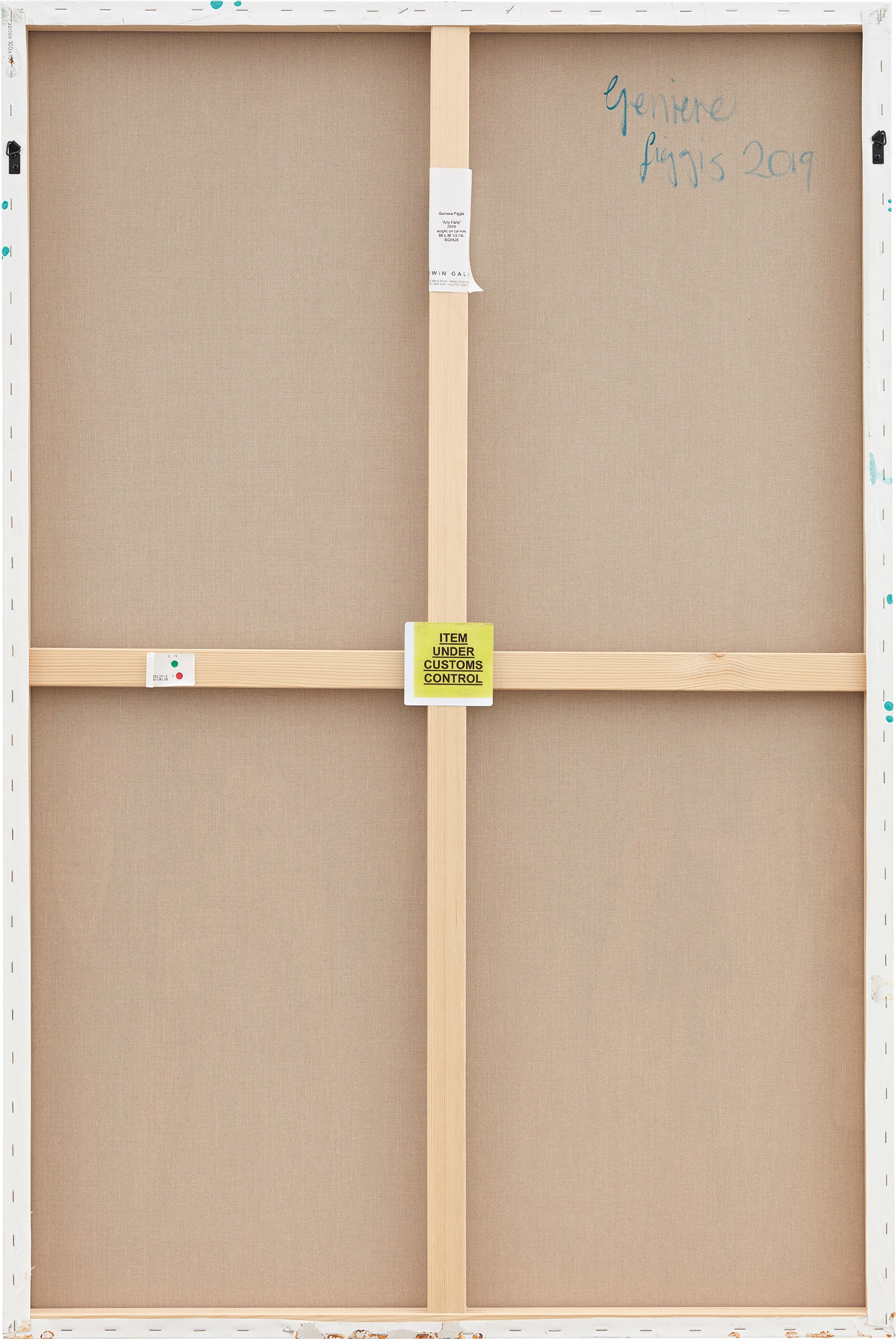



4
Genieve Figgis
Arty Party
signed and dated 'Genieve Figgis 2019' on the reverse
acrylic on canvas
149.8 x 99.6 cm. (58 7/8 x 39 1/4 in.)
Painted in 2019.
Full-Cataloguing
Genieve Figgis is a contemporary Irish painter known for her witty and subversive take on art canon masterpieces by artists as diverse as Jean-Honoré Fragonard, Francisco Goya, and Édouard Manet.
Arty Party was unveiled at the artist’s 2019 ‘High Society’ exhibition at the Baldwin Gallery, Aspen. With a particular predilection for satirising social norms of centuries past, Figgis uses Arty Party to cast an eye upon the Belle Époque, a golden age of joie de vivre, economic prosperity, and technological and scientific progress in European culture spanning the period between the birth of the French Third Republic in 1870 and the outbreak of the First World War. Centred around Parisian society, Belle Époque was a term applied to the era in retrospect, as a tribute to the period’s decadence, optimism and frivolity. The Belle Époque was considered a harbinger of modernity - an epoch of beautiful clothes and the peak of luxury living for a highly privileged class in society. It was eagerly chronicled by Belle Époque artists such as Jean Béraud, a French painter and contemporary of Édouard Manet and Edgar Degas, whose paintings depicted the life (and nightlife) of the cream of Parisian society indulging in their leisurely pursuits – at the opera, at the races, promenading along grand boulevards, or reclining in opulent interiors (see for example Béraud’s, Le Monologue, 1882). Those wealthy enough to commission a ‘swagger portrait’ requested to be portrayed full-length to show off their lavish, fashionably au courant outfits.
But Figgis’s dark humour replaces Belle Époque-style playfulness with the eerie and strange. What is at first glance a rather grand portrait of an elite group of high society revellers quickly gives way to a disquieting, unsettling mood. Lushly painted textures and attentive details elevate Figgis’s work – lustrous golden silks, a luxuriantly ruffled collar, diaphanous violet chiffon, fashionably puffed mutton sleeves, claret red wine swirling in a crystal glass – and contrast with the ghoulish, skull-like faces of the macabre group of partygoers. Harshly lit, the scene is no longer a comfortable vehicle of frivolity or fantasy. Figgis’s signature technique of swirling dripped or thickly applied acrylic paints causes her genteel subjects to distort and puddle where they stand. The guests stare directly - even confrontationally - at the viewer, their teeth bared in a rictus grin and bulging eyes ringed with bloodlike smears of makeup daubed across their faces. The viewer is no longer a mere spectator to the festivities, but marked out as an interloper. The warped features and expressions of Figgis’s characters are reminiscent of fellow Irish artist Francis Bacon’s ‘screaming mouth’ paintings and introspective self-portraits, which embodied a host of post-war cultural anxieties as well as Bacon’s personal demons. The surreal tableau unfolds in front of a sickly rich turquoise background, whilst the imposing full-length ‘swagger portrait’ of a woman posing outdoors in her finery mimics the mocking stances and facial expressions of the guests.
With an ironic yet incisive vision of the boundaries between the classical and the contemporary, Figgis posits herself as a postmodern chronicler of social and cultural norms and anxieties. She lampoons Western commercial consumption and the bourgeois tastes of the rich middle-class dutifully captured by Belle Époque artists, bringing such subjects firmly into the present day with a mixture of satire and poignant real depictions of life.
An unconventional rising star in the art world, Figgis was a relative latecomer to painting but caught the attention of the American visual artist Richard Prince on Twitter, who went on to purchase one of her works and introduced her to the New York art scene. She is represented by Almine Rech Gallery in London and Half Gallery in New York.
Arty Party was unveiled at the artist’s 2019 ‘High Society’ exhibition at the Baldwin Gallery, Aspen. With a particular predilection for satirising social norms of centuries past, Figgis uses Arty Party to cast an eye upon the Belle Époque, a golden age of joie de vivre, economic prosperity, and technological and scientific progress in European culture spanning the period between the birth of the French Third Republic in 1870 and the outbreak of the First World War. Centred around Parisian society, Belle Époque was a term applied to the era in retrospect, as a tribute to the period’s decadence, optimism and frivolity. The Belle Époque was considered a harbinger of modernity - an epoch of beautiful clothes and the peak of luxury living for a highly privileged class in society. It was eagerly chronicled by Belle Époque artists such as Jean Béraud, a French painter and contemporary of Édouard Manet and Edgar Degas, whose paintings depicted the life (and nightlife) of the cream of Parisian society indulging in their leisurely pursuits – at the opera, at the races, promenading along grand boulevards, or reclining in opulent interiors (see for example Béraud’s, Le Monologue, 1882). Those wealthy enough to commission a ‘swagger portrait’ requested to be portrayed full-length to show off their lavish, fashionably au courant outfits.
But Figgis’s dark humour replaces Belle Époque-style playfulness with the eerie and strange. What is at first glance a rather grand portrait of an elite group of high society revellers quickly gives way to a disquieting, unsettling mood. Lushly painted textures and attentive details elevate Figgis’s work – lustrous golden silks, a luxuriantly ruffled collar, diaphanous violet chiffon, fashionably puffed mutton sleeves, claret red wine swirling in a crystal glass – and contrast with the ghoulish, skull-like faces of the macabre group of partygoers. Harshly lit, the scene is no longer a comfortable vehicle of frivolity or fantasy. Figgis’s signature technique of swirling dripped or thickly applied acrylic paints causes her genteel subjects to distort and puddle where they stand. The guests stare directly - even confrontationally - at the viewer, their teeth bared in a rictus grin and bulging eyes ringed with bloodlike smears of makeup daubed across their faces. The viewer is no longer a mere spectator to the festivities, but marked out as an interloper. The warped features and expressions of Figgis’s characters are reminiscent of fellow Irish artist Francis Bacon’s ‘screaming mouth’ paintings and introspective self-portraits, which embodied a host of post-war cultural anxieties as well as Bacon’s personal demons. The surreal tableau unfolds in front of a sickly rich turquoise background, whilst the imposing full-length ‘swagger portrait’ of a woman posing outdoors in her finery mimics the mocking stances and facial expressions of the guests.
With an ironic yet incisive vision of the boundaries between the classical and the contemporary, Figgis posits herself as a postmodern chronicler of social and cultural norms and anxieties. She lampoons Western commercial consumption and the bourgeois tastes of the rich middle-class dutifully captured by Belle Époque artists, bringing such subjects firmly into the present day with a mixture of satire and poignant real depictions of life.
An unconventional rising star in the art world, Figgis was a relative latecomer to painting but caught the attention of the American visual artist Richard Prince on Twitter, who went on to purchase one of her works and introduced her to the New York art scene. She is represented by Almine Rech Gallery in London and Half Gallery in New York.